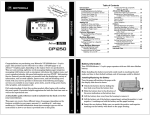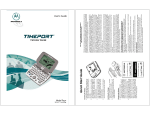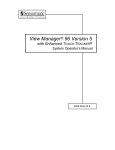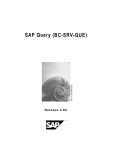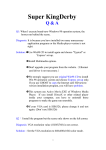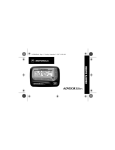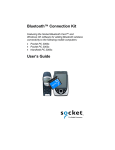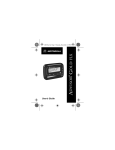Download Motorola P730 Pager User Manual
Transcript
Table of Contents Introduction ............................................. 1 Getting Started Installing/Replacing the Battery......... 2 Control Buttons and Status Screen .... 4 Turning Your Pager On........................ 5 Turning Your Pager Off ....................... 5 Backlight .............................................. 6 Sending a Test Message....................... 6 The Function Menu.............................. 7 Setting Up Setting the Time and Date ................. 8 Setting the Pager Alert Mode .............. 9 Setting the Pager Alert Pattern .......... 9 Setting the Pager Alarm .................... 10 Quiet Time.......................................... 11 Personal Messages Receiving/Reading Personal Messages ....................................... 14 Maildrop Messages Receiving/Reading Maildrop Messages ....................................... 17 Setting the Alert for a Maildrop........ 20 Super Maildrop Messages Receiving/Reading Super Maildrop Messages ....................................... 22 Congratulations on purchasing your Motorolaâ TimeportTM P730 Information Pager. This new and exciting, eight-line word-messaging display pager integrates messaging with features such as emergency call, phone list, display zoom, and event reminder/calendar. I D K Folders Moving Messages to Folders .............. 36 Reading Messages in Folders............. 37 Moving Messages Between Folders... 38 Moving All Personal Messages to the Trash................................... 39 Deleting Messages from the Pager (Emptying the Trash) ................... 40 Completing Your Tasks in the Task Folder ................................... 41 Setting Reminder Alarms for Events 43 Changing the Reminder Alarm ........ 45 Features ................................................. 45 Use and Care ......................................... 48 Your Timeport P730 Information Pager operates with one AAA-size alkaline battery. Installing/Replacing the Battery GETTING STARTED This pager can receive three different types of messages depending on the features available in your pager: personal ( ), maildrop ( ), and super maildrop ( ). Full understanding of what this exciting product offers begins with reading this user’s guide. It provides helpful suggestions for both the firsttime user as well as the experienced user. Advanced Messaging Quickview Folder and Quickview ...... 27 Breaking the Topic/Quickview or Quickview Folder Relationship .... 30 Price Alert........................................... 31 Search String...................................... 32 Price Charts ....................................... 33 Other Graphics ................................... 35 Battery Information INTRODUCTION Advanced information services (FLEX™ Information Service Protocol) provide simple yet powerful tools for displaying a variety of information, such as stock updates, sports scores, and late-breaking news. Check with your service provider to determine if the following messaging services are available in your region: price alerts, search string, price charts, other graphics, and emergency call. Turning the Alert for a Super Maildrop On and Off..................................... 25 Turning the Alert for a Specific Topic On and Off..................................... 26 A detachable Quick Reference Card is included on the back cover for your convenience. 1 2 Turn the pager off and place the pager with the display side down as shown. Unlock the battery door by sliding the door lock away from the battery door. Slide the battery door in the direction of the arrow indication on the battery door. Lift the battery door away from the housing to remove it. Lift the battery out of the battery IPB 971006 O compartment, noting the positive (+) and negative (-) markings on both the battery and the pager housing. Insert the new battery. Make sure you match the positive and negative markings on the battery with those on the pager housing. Control Buttons and Status Screen Note: Installing the battery incorrectly could result in resetting the alert mode and time to their default settings, and in deleting all messages. GETTING STARTED Slide the battery door lock toward the bottom of the pager to lock the battery door. GETTING STARTED Align the grooves on the battery door with the grooves on the pager housing and slide the battery door closed. Folders eijmkezBq aob h u t On/Read Button Function/Select Button Directional Buttons xs v w 3 L HY ):)) m )%/)! DDDD IbIIIIIILI55555555 R q h ao b ESCAPE Pager Status On/Read Function/ Select Directional Used to turn the pager on and to read a message. Used to display the Function menu and to select pager settings. Used to move around the display and through menus. 4 Turning Your Pager On Backlight Press u to turn your pager on. A start-up message is momentarily Your pager’s display can be illuminated in low light conditions. You can manually turn the backlight on and off by pressing and holding t for at least two seconds. Battery status (Full) Power On Alert Mode (Audible) HY Time L› ):)) Day and Date m )%/)! (Blank screen) Status Screen example Turning Your Pager Off From any screen, press and release t until ESCAPE is displayed. (z is flashing.) Press v to move to e(TURN OFF). GETTING STARTED Press any button to stop the start-up alert. While the pager is on and no activity is taking place, the Status screen is displayed. GETTING STARTED displayed and your pager activates the currently selected alert. Press t to turn the pager off. The TURN OFF? prompt is displayed. Press t again. The pager is now off and the screen is blank. 5 6 Sending a Test Page to Yourself It’s a good idea to test your pager and service by sending a page to yourself. Start by using the phone number, web site or email address (and PIN, if required) your service provider gave you, then enter a short message. If you are sending a word message from a phone, an operator will assist you; otherwise press the phone buttons to enter a numeric message or type a message and send it. While you are waiting for the message to reach your pager, refer to page 14 for more information about how to read a message. If your pager does not receive the message within a few minutes, contact your service provider. After you’ve tested your pager, read the rest of this guide to learn about the many useful features of your new pager. The Function Menu Setting the Time and Date The Function menu provides access to many of the pager’s features through a series of icons and prompts. On the Function menu, press vor s to move to i(SET TIME/ALARM). Press t. The Set Time screen is displayed. Pager status Press t to access the Function menu. An example is shown below. HY Function prompt Functions ESCAPE eijmkezBqhaobK Function Menu example Note: Some icons may or may not be displayed on your pager, depending on your pager’s features and whether or not it has messages SETTING UP R q h a o b Folders SETTING UP Set Time fields ):)) S )!/)! H_ 00:00| 01/01/00H J 00:00| --/--/-SET TIME Set Time Screen example Press s to move to the hour field. Press x or w to adjust the hour. Press s to move to the first digit of the minutes field. Press x or w to adjust the first digit of the minutes. Repeat Steps 5 and 6 to adjust the second digit of the minutes field, the method of time measurement (AM, PM, or 24hr ), month, date, and year fields. Getting Around the Function Menu Press either v or s to move within the Function menu. To exit from any menu without accepting changes, press u. Press t to accept the time and date changes. 7 8 Setting the Pager Alert Mode Press t to accept the selected alert. The pager emits the selected alert (for any selection except k) as it returns to the Status screen. The alert can be set as either audible or silent. On the Function menu, press v until one of two possible prompts is Setting the Pager Alarm displayed: SET SILENT ALERT ([ k] to change from audible to silent alert mode) or SET AUDIBLE ALERT ([ f] to change from silent to audible alert mode). The pager must be set for an audible alert to select an alert pattern. There are ten alert pattern options: one standard alert (1), seven different pleasing alerts (2 through 8), a chirp alert ( ), and no alert (k). O On the Function menu, press s to move to e (CHOOSE ALERT). Press t. The Alert pattern screen is displayed. O SETTING UP Setting the Pager Alert Pattern You can set two clock-type alarms: • One-time only—Specify the time and date. • Daily—Specify the time only. The alarm expires daily at the same time. SETTING UP Press t to accept the new alert mode. The pager emits a sample of the new alert. 1 2 3 4 5 6 7 8 L› On the Function menu, press s to move to i (SET TIME/ALARM). Press t. The Set Time screen is displayed. Press w or x . The Set Alarm screen is displayed. Pager status Set Alarm fields HY L› _ 12:05" HJ 12:00- !@:)% m )%/)! 05/01/00 --/--/--H SET ALARM Set Alarm Screen example k J STANDARD ALERT Press s. The alarm indicator ( ) flashes. Alert Pattern Screen example Press w to change the indicator from Press v or s to move to the desired alert. A sample of each alert is emitted as you scroll through the selections. Press s to move to the hour field. 9 10 J (alarm off) to r (alarm on). Press x or w to adjust the hour. Press t. The Set Quiet Time screen is displayed and the quiet time indicator (either if off or if on) flashes. 7 Repeat Steps 6 and 7 until you have set both digits of the minutes field and the method of time measurement (AM, PM, or 24hr) field. R R R Quiet Time Quiet Time turned off indicator SETTING UP Press t to accept the alarm setting. is displayed, indicating the alarm is In the upper-left corner of the pager, flashes and the pager either vibrates or emits set. When the alarm expires, an audible alert until you press a button. If it is a one-time alarm, disappears from the Status screen after you press a button. On the Function menu, press v to move to j (SET QUIET TIME). 11 )%/)! END 7 12:00- 12:00- Set Quiet Time Screen example Press x or w to turn quiet time on (from are turning off quiet time, skip to Step 10. 7 to c) or off (from c to 7). If you Press s to move to the starting hour field. Press x or w to adjust the hour. Press s to move to the first digit of the minutes field. Press x or w to adjust the first digit of the minutes. 12 When you are finished, press t to accept the selected quiet time period. Receiving/Reading a Personal Message H PERSONAL MESSAGES SETTING UP One of the following indicators is displayed in the upper-left corner of the screen: Y ):)) m Repeat Steps 4 through 8 to enter the ending quiet time setting. Note: If the end time is equal to the start time, the Quiet Time function is turned off. W Note: When quiet time is turned on and the pager is set for audible alert, is displayed in the upper-left corner of the pager except during the actual quiet time period. L› START Repeat Steps 6 and 7 for the second digit of the minutes field and for the method of time measurement field. You can change between AM and PM, but if you are using the 24hr time measurement, you cannot change it here. The pager can receive and store new messages without any alerts for a certain period of time on a daily basis, regardless of whether the pager is in audible or silent alert mode. All you have to do is turn Quiet Time on and set the time period desired. After you turn quiet time on, it activates on a daily basis in the upper-left corner of the pager) until you turn it off. (indicated by W - Quiet time on with no unread messages W with H flashing - Quiet time turned on with stored, unread messages. H - Quiet time off with no unread messages. H flashing - Quiet time off with stored, unread messages. HY Pager status SETTING UP If this is a one-time only alarm, also use Steps 6 and 7 to set the month, date, and year fields. If this is a daily alarm, leave the dashes (-- ) in the date fields and go to the next step. Note: Only AM or PM can be changed. If you are using the 24hr time measurement, you cannot change it here. c A flashing in the upper-left corner indicates there is at least one unread message in your pager. If programmed with reminder alerts, your pager alerts periodically to remind you there are unread messages. Each flashing personal message indicator ( ) on the Status screen represents an unread message. A non-flashing represents a previously read message. If your pager has not received any messages, there are no personal message indicators displayed on the Status screen. D D When your pager has received a message and an alert is being emitted use the following steps to read the message. Press any button to stop the alert. The new message is automatically stored, along with the time and date it was received. The Status screen displays the number of the message (03: in this example because it is in the third message slot) and the first line of the message. Pager status Personal messages received First line of new message HY L› DDPDDD R ):)) m q h 03:Call me a 14 ob before New Message example 13 )%/)! you Press u to display the first full screen of message text. Continuation indicator (flashing) New Message example l If a flashing is displayed in the bottom-right corner of the screen, the message continues beyond the current screen. If there is no flashing , the message is not continued beyond the current screen. l Use one of the reading options: • To read the rest of the message line-by-line, press and release w repeatedly. • To read the rest of the message screen-by-screen, press and release u repeatedly. • To go to the top of the current message, press x . • To rapidly scroll through the rest of the message, press and hold down u or w. PERSONAL MESSAGES First 8 lines of personal message #3 The end of a message is indicated by the time and date the message was received. PERSONAL MESSAGES 03:Call me before you leave the office. I have some errands for you to do. If you leave before 6:00, leave a message for me at work. If you are later than that, call me at home. I hope you get l 15 16 K DDPDDDD O R q ha o b Maildrop with Audible Alert example Maildrop indicator with silent alert DDPDDDD K R q ha o b Maildrop with Silent Alert example MAILDROP MESSAGES Maildrop indicator with audible alert 17 18 O You can set an alert for each maildrop (indicated on the Status screen by ). However, the default is no alert ( ). See “Setting the Alert for a Specific Maildrop” on page 20 for more information about how to set a maildrop alert. K done in 01/01/00 time. End of Message example When you have finished reading a message, press u to return to the Status screen. To save a message, move it to a folder. See “Moving Messages to Folders” on page 36 for more information. To read other personal messages, press v or s to select the message you want to read. When a message slot is selected, the personal message indicator changes from to P. D Repeat Steps 2 through 5 to read your messages. K is highlighted and the indicator changes to L. Last message read is highlighted DDPDDDD Alert-disabled maildrop indicator (a flashing icon indicates KK a new unread message) flashing MAILDROP MESSAGES O everything 12:15 If the maildrop is alert-disabled (K), press any directional button until the Receiving/Reading Maildrop Messages Your pager is capable of receiving Maildrop messages (Information Services). Maildrop messages are received the same way as personal messages. One maildrop (indicated by for audible alert or for silent alert) can store up to eight different messages designated for that maildrop. Maildrop messages are located on the second row of the display. If no maildrop messages have been received, no maildrop icons are displayed. End of message Time and date message was received R q ha o b Alert-disabled Maildrop Message example If the maildrop is alert-enabled, press any button to stop the alert. The first line of the unread maildrop is displayed while flashes. Alert-enabled maildrop indicator (a flashing icon indicates a new unread message) O DDDDDDD OOO R q ha o b First line of alert-enabled maildrop Sports Update: Alert-enabled Maildrop Message example Press u to display the Maildrop message. If your pager is equipped with Maildrop history, the next screen is the Maildrop history list. This is a list of up to eight different messages for this maildrop. The most recently received message is displayed first ( ), followed by up to seven history messages ( ). Update: Update: Update: Update: Update: Maildrop History List example Note: Unique to maildrops, when a new message is received, the newest one ( ) is displayed at the top of the list. The older message is moved down to one of the history slots and is now displayed with . When this happens, the older history message is considered to have been read, whether it actually has been or not. If this feature has not been turned on by your service provider, the maildrop history files may not be available on your pager. K U [ If is pointing to the message you want to read, go to Step 4. Otherwise, press w until the message you want is at the top of the list. MAILDROP MESSAGES U l MAILDROP MESSAGES First maildrop message History maildrop message History maildrop message K [K Sports U Sports U Sports U Sports U Sports Press u to display the first full screen of message text. If a continuation indicator is displayed ( ), the message continues beyond the current screen. Reading the rest of the maildrop message is the same as reading a personal message. Note: The list moves up; the indicator does not move down. When you have finished reading the message, press u until the maildrop history screen is displayed. To read another message in this same maildrop, repeat Steps 3 and 4. When you have finished reading the messages in this maildrop, press x to return to the Status screen. To save a message, move it to a folder. For more information, see “Moving Messages to Folders” on page 36. K O L or on To read messages in other maildrops (each indicated by a flashing the Status screen), press v and/or s until the maildrop is highlighted ( or ). Repeat Steps 3 through 6 to read messages in the selected maildrop. @ Setting the Alert for a Specific Maildrop You can establish different alerts for different maildrops. You can also have some maildrops with turned on alerts and others with alerts turned off. There are two different procedures for setting alerts depending on the current alert mode (either audible or silent) of the pager. To turn a maildrop alert on or off when pager is in audible mode: Make sure the maildrop you want ( 19 20 On the Function menu, press s to move to n (CHOOSE MAILDROP ALERT). L @ @ L To turn a maildrop alert on or off when pager is in silent mode: Make sure the maildrop you want ( K or O) is highlighted (L or @). On the Function menu, press s to move to n (SET MAIL ALERT ON) to turn the alert on or ^ (SET MAIL ALERT OFF) to turn the alert off. Press t to accept the alert. If you turned the alert on, the pager (if equipped with a vibrator) vibrates as it returns to the Status screen and whenever a message is received for this maildrop. The maildrop indicator to (for alert on) or from to (for alert off). has changed from L @ @ L MAILDROP MESSAGES Press t to accept the alert. If you turned the alert on, the pager emits this alert as it returns to the Status screen and whenever a message is received for this maildrop. The maildrop indicator has changed from to (for alert on) or from to (for alert off). 21 SUPER MAILDROP MESSAGES Receiving/Reading Super Maildrop Messages Press t. The Alert pattern screen is displayed. Press either v or s until the alert you want flashes. A sample of each alert is emitted as you scroll through the selections. Select k (NO MESSAGE ALERT) if you want to turn the alert off. K or O) is highlighted (Lor @). 22 This feature, along with the use of topics, allows your pager to receive and store more powerful and sophisticated types of information services. The super maildrop feature allows the pager to store up to 3000 topics. Each of these topics can contain multiple messages. Note: Please check with your service provider to determine if your pager’s super maildrop feature is turned on. b Below is an example of super maildrops with alerts turned on ( ) and alerts turned off ( ) as displayed on the Status screen. I Super maildrop messages with one alert turned on and one alert turned off DDDPDDD bI R q h a o b Status Screen with Super Maildrop Message Indicators example If no super maildrops have received messages, no super maildrop icons are displayed. You can turn on alerts and set the type of alert at the super maildrop level and at the topic level (pages 25 and 26). Additionally, with quickview, you can jump directly from the Status screen to the message level. For more information about quickviews, see page 27. If the super maildrop’s alert is turned on, press any directional button until the flashing I is highlighted (and the indicator changes to G). If the super maildrop’s alert is turned on, press any button to stop the alert. The first topic containing the unread message displays while flashes. @ Press u to display the next screen. A list of topics is displayed as shown below. Alert-turned on topic Alert-turned off topic Alert-turned on topic “ Alert-turned off topic “ “ “ Flashing topic list continuation indicators Company [^nCompany A B C n Company A n Airline Cruise company ^ company ^ Legal k ^ Film company l ^ Car company Super Maildrop Topic List example Note: Each topic indicator (n or ^) containing unread messages flashes until the messages for that topic have been read. Because there can be more than eight topics per super maildrop, the topic list continuation indicator/s ( or or both) will also flash if there are unread messages in topics either above or below the currently displayed screen. k l SUPER MAILDROP MESSAGES I SUPER MAILDROP MESSAGES b A flashing (alert turned on) or (alert turned off) on the Status screen indicates at least one unread super maildrop message has been received. 23 24 If the super maildrop does not have history capability, then press u until the super maildrop topic list is displayed. To read another topic, repeat Steps 3 to 6. b I G @ Turning the Alert for a Super Maildrop On and Off Turning an alert on or off for a super maildrop is the same procedure as for a maildrop (see page 20), except for the screen indicators. Make sure the super maildrop (I or b) you want is highlighted (G or @). See page 20 for the beginning of the maildrop alert procedures. When you (alert off) or (alert have finished, the super maildrop indicator is either on). G @ ADVANCED MESSAGING To read messages in other super maildrops (each indicated by a flashing or on the Status screen), press v and/or s until the super maildrop is highlighted ( or ). Perform Steps 2 through 8 to read messages in the selected super maildrop. Press u to display a list of all messages received for this topic as shown in the example. The most recently received message is displayed first ( ), followed by the list of history messages ( ). K U First message Second message Third message Company [K Company U Company U A A A 23.50 27.00 22.65 Message History List example K or U) flashes until it has been read. Note: Each message indicator ( [ If is pointing to the message you want to read, go to Step 6. Otherwise, press x or w until the message you want is at the top of the list. Press u to display the first full screen of message text. If a continuation indicator is displayed ( ), the message continues beyond the current screen. Reading the rest of a super maildrop message is the same as reading a personal message. l When you have finished reading the message and if the super maildrop has history capability, press u until the message history list is displayed. To read another message from this same topic, repeat Steps 4 through 6. Turning the Alert for a Specific Topic On and Off ADVANCED MESSAGING When you have finished reading all of the messages, press x until the Status screen is displayed. To save a super maildrop message, move it to a folder. See “Moving Messages to Folders” on page 36 for more information. Press x or w until the topic you want is at the top of the list. If the selected super maildrop has history capability, continue with step 4. If the super maildrop does not have history capability, skip to step 6. 25 26 Topic alerts can be turned on only if the entire super maildrop is alert-enabled. After assigning a unique alert to the super maildrop, that same alert is used for each alert-enabled topic within that super maildrop. Turning an alert on or off for a topic is the same procedure as for a maildrop alert. Make sure the topic list is displayed and the topic you want (^ or n) is at the top of the list. See page 20 for the beginning of the maildrop alert procedures. When you have finished, the topic indicator is either ^ (alert off) or n (alert on). Advanced Messaging The Timeport P730 Information Pager can also be programmed to receive financial services such as stock information or exchange rates, if your service provider offers this type of service in your region. The information can be arranged for easy viewing by separating it into a number of super maildrops. Information can be viewed from the topics in super maildrops (see page 22 for reading super maildrop messages). Stock information may include, the company name, current stock price, transaction volume, open and close price for the day etc., depending on the information provided by your service provider. The Timeport P730 Information Pager has been designed to provide you with the following powerful advanced messaging features. Please check with your service provider to determine if the "price alert," "price chart," and "other graphics" features are available. • Price Alert - allows you to set a high price and a low price for a selected stock. The pager alerts if either price occurs. • Search String - allows you to quickly search for a key word or stock. • Price Charts - generates charts of stock prices or other numeric instruments. • Other Graphics - displays bitmapped graphics. Check with your service provider to determine if such information is available. Quickview Folder (R) and Quickview (J). The quickview folder (R) allows you to store selected super maildrop topics from the original list of topics. This is useful for information that you want to read quickly. You can store up to 50 topics within the same or different super ADVANCED MESSAGING • Breaking the Topic/Quickview or Quickview Folder relationship allows you to break a topic relationship with a quickview folder or quickview and thus removing the quickview assignment for the topic. G @ ADVANCED MESSAGING • Quickview Folders and Quickview - gives you immediate access to frequently read information. maildrops in the quickview folder. To put a topic into a quickview folder, make sure the super maildrop containing the topic you want is highlighted ( or ) on the Status screen. Press u. The topic list is displayed. After using either x or w to position the desired topic at the top of the list, press t to display the Function menu. Press s to move to R (ADD TO QUICKVIEW FOLDER). Press t. The selected topic is now in the quickview folder and the pager returns to the list of topics. Press either x or w to return to the Status screen. The selected topics can now be read in the quickview folder, see page 37. First line of quickview message n n Company Company A B 23.50 27.00 ADD TO QUICKVIEW FOLDER mezBRJqhaob Add to Quickview Folder example The quickview (J) allows you to read a super maildrop message directly from the Status screen. This is useful for information that you are want to read quickly. You can assign up to 10 quickviews to different topics within the same 27 28 or different super maildrops. To put a topic into quickview, make sure the super maildrop containing the topic you want is highlighted ( or ) on the Status screen. Topics can be added to a quickview folder or a quickview, but not both. After a topic is added to the quickview folder or quickview, the Function menu only shows the T or I “REMOVE FROM QUICKVIEW” prompt. Press u. The topic list is displayed. Breaking the Topic/Quickview or Quickview Folder Relationship Press s to move to J (ADD TO QUICKVIEW). Press t. The selected topic is now a quickview and the pager returns to the list of topics. Press either x or w return to the Status screen. In the example, J is displayed, indicating the quickview has been established. DDDDDDD bI R q J h a o Quickview indicator b Note: The original topic information still remains in the topic list. You must access the original topic in the super maildrop to define an alert for the same topic in the quickview folder or quickview. ADVANCED MESSAGING After using either x or w to position the desired topic at the top of the list, press t to display the Function menu. ADVANCED MESSAGING G @ There are two different locations from which you can break a topic relationship with quickview folder or with quickview and thus delete the quickview. • From the R or J displayed on the Status screen (representing the relationship you want to break) • From the quickview message itself. Note: This procedure is only for breaking the relationship between a topic and a quickview; no messages are being deleted or moved. You cannot move a quickview message directly to Trash. However, you can move the same message from its original super maildrop position to the Trash. The quickview relationship still exists for this topic and when a new message is received for this topic, it can still be read using R or J. Press t to display the Function menu. Press s to move to T or I (REMOVE FROM QUICKVIEW). Press t. The quickview relationship is broken for the topic chosen in R or J. Note: You did not delete or move any messages; you only removed the 29 30 Press s and then either x or w to set the ON/OFF price alert ( a). quickview assignment for this topic. Use the directional keys v,x ,w,s to move to the High value field and Low value field. Use x or w to change the high and low price. To set a price alert, make sure the topic in the quickview folder, or quickview is highlighted. Press t. The Function menu is displayed. Press s to move to S (SET PRICE ALERT). Press t. The following screen displays. Field to ON/ OFF Price alert Space if less than 8 digits long Ha PRICE ALERT High ----40.12 Current ----40.12 Low ----40.12 H H Flashing Fields to enter High/Current/Low price alert value ADVANCED MESSAGING You can set the high or the low value for the topics that are in the quickview folder or quickview (for example, a stock price). A topic whose price alert value is reached (high or low), causes a price alert and price alert icon flashes until read. The cursor is automatically set to the quickview folder or quickview which contains the topic whose price has reached the high or low value. Press u to read the message. ADVANCED MESSAGING Price Alert Press t to set the price alert. U Field to ON/ OFF Price alert (OFF in this case) PRICE ALERT High---100.00 Current----40.12 Low----01.20 H H H Flashing Set Price Alert example Search String The search string function allows you to quickly access key words or numerical values within the first 16 characters of each super maildrop message. Press t to display the Function menu. Press s to move to B (SEARCH). Use the directional keys v,x ,w,s to input your search string (up to 8 characters). Press t to start the search. Price Alert example 31 32 ---SEARCH l Search String example Note: The Search String capability is limited to numeric values only for Hebrew, Arabic, and multiple language pagers. Price Charts The Timeport P730 Information Pager automatically plots a chart of stock prices or other numerical values for instruments or topics in your quickview (not quickview folder). Ten stock price charts can be displayed, one for each quickview you set up. The price charts are based on the values in the original topic messages and start collecting price data for charting once your selected information is put into quickview. Note: The date and time setting on the Timeport P730 Information Pager must be correct otherwise the charts will not reflect the current information. ADVANCED MESSAGING SEARCH STRING 1234 START ADVANCED MESSAGING If there is a match to the search string, the associated information is displayed on the screen. However, if there is no match, then the prompt “NO MATCH” displays, and the cursor is positioned for you to enter another string to search. 33 34 A moving window (the timeframe, as determined by your service provider) of price points is tracked for numerical topics that are put into quickview. The charts also display the maximum and minimum price reached. A vertical dotted line separates the previous day’s and current day’s prices or values as the chart crosses over from previous day to current day. Note: For the period when the pager senses out of range, the chart leaves a gap until it is back in range. Y L› ):)) m )%/)! Price Chart example To view the price charts, make sure that the quickview containing the numerical topic that you want is highlighted (J) on the Status screen. Pressing u causes the first full screen of message text (such as stock information) to display. Continue pressing u until the message text is completed. Press u again to display the stock chart. Other Graphics • Event List (o)—used to set an alarm for specific messages The Timeport P730 Information Pager can also display graphics such as a stock index chart, if your service provider offers this feature. An example of a graphic that you may receive on your pager is shown in the figure below. • Trash (b)—used to store messages to be deleted ).))m )%/)! 4619 4574 4529 4485 4440 4395 4350 +3.00 +2.00 +1.00 +0.00 -1.00 -2.00 -3.00 Graphic example Introduction to Folders Your pager has a system of folders in which you can save and organize specific messages. The folders are: FOLDERS L› FOLDERS Y Note: The empty trash function (C) must be used to actually delete the messages from your pager. For more information, see page 40. Most of these folders require the same procedures to move messages between them and to them from the Status screen (except for the Event List, which has additional procedures). The procedures in this section apply either to all folders (as in “Moving Messages to Folders”) or to specific folders (as in “Deleting Messages from the Pager (Emptying the Trash)”. Moving Messages to Folders After moving a message into a folder, you cannot move it back to the Status screen. It can only be moved to another folder. On the Status screen, highlight the icon representing the message you want to move (for example, , , or ). P@ L Press t. The Function menu is displayed. • Quickview Folder (R)—used to store important messages for immediate access (see page 27 for more information) Press s until the target folder icon flashes. • Personal (q)—used to store personal messages and maildrop messages Press t. The message you highlighted is removed from its slot on the Status screen and is moved to the specified folder. • Phone List (h)—used to store phone numbers and names • Task List (a)—used to create a “to do” checklist for specific messages 35 36 If this move was to any folder except the Event List, you have finished this procedure. If this move was to the Event List, go immediately to “Setting Reminder Alarms for Events (the Event List)” on page 43. Press u to begin reading the message. Moving Messages Between Folders Before you can move a message from one folder to another, you must first have the message text displayed on the pager. (This is only necessary between folders, not from the Status screen to a folder. To review that procedure, go back to Steps 1 through 4 starting on page 36.) Note: Any folder containing stored messages no longer displays the FOLDER EMPTY indication when highlighted. Press u to open the folder. A list of messages is displayed. In the example below, a personal message is in the Personal Folder. It is displayed with its personal message indicator ( ). D First line of personal message [D Call me before you FOLDERS On the Status screen, press any directional button until the folder you want to open is highlighted: V (Quickview Folder), l (Personal Folder), r (Phone List), a (Task List), f (Event List) or g (Trash). FOLDERS Reading Messages in Folders Note: If this same personal message is in either the Phone List, Task List, or Event List, the message indicator changes from (Personal (Task List), or (Event List), respectively. If Folder) to (Phone List), a message is moved to the Trash, the indicator reverts back to its original personal ( ) or maildrop ( ) format. v K C With the text of the message displayed, press t. A folder-specific Function menu is displayed as shown in the following example. mezqaob Phone List Function Menu example Note: This is an example of the Phone List Function menu because the Phone List icon (h) is not displayed. The folder icon for the current folder is not displayed. Message in the Personal Folder example ! D Note: You can freely move messages between all folders (including the Trash). However, after you have moved a message to a folder, you cannot move it back to the Status screen. D Press s until the target folder (the folder to which you are moving this message) flashes. The MOVE TO (folder name) text is displayed, where (folder name) is the name of the target folder. Press w until the message you want to read is at the top of list. 37 38 Press t. The message is moved to the new folder and the Status screen is displayed. If this message was the last one in the folder it came from, the Status screen displays FOLDER EMPTY. Press t. All previously read personal messages are moved to the Trash. Note: To remove these from the pager, you must empty the trash as described in the next procedure. Note: If you are moving this message to the Event List, additional steps are involved. See “Setting Reminder Alarms for Events (the Event List)” on page 43. Note: If the message you moved was a super maildrop topic with a is highlighted (before any new quickview relationship, whenever messages are received), only QUICKVIEW is displayed on the Status screen when you attempt to read the quickview message. Deleting Messages from the Pager Rather than having to individually move all previously read personal messages to the Trash, you can move them together using K (MOVE ALL TO TRASH). Note: This function only moves previously read personal messages and is only available on the Status screen. Maildrop and super maildrop messages must be individually moved to the Trash. FOLDERS Moving All Personal Messages to the Trash FOLDERS a (Emptying the Trash) Deleting messages from your pager is actually a two-procedure process. After you have moved the message(s) to the Trash, you must use the empty trash function (C) to actually remove the message(s) from your pager’s memory. While messages are in the Trash, they can still be moved to other folders. Only when you empty the trash are you actually deleting the messages from your pager. On the Status screen, press s until g (TRASH) is highlighted. Press u. A list of all messages in the Trash is displayed. Press t. The Trash Function menu is displayed. Press s until EMPTY TRASH (C) is displayed as shown in the example below. P Make sure a previously read personal message is highlighted ( ) on the Status screen. Press t to display the Function menu. Press s until K (MOVE ALL TO TRASH) flashes. 39 40 Note: C is only displayed when there are messages in the Trash. Maildrop message Personal message sports [K— Call D Press u. The Task List is opened and a list of tasks is displayed. Update: me before Uncompleted task Uncompleted task Completed task Uncompleted task EMPTY TRASH ezCqhao m Mary at work. me before John at home. your mother Task Messages in Task List example Trash Function Menu example Note: If you continue with this procedure, all messages in the Trash are deleted, not just the one at the top of the list. Press t. The messages are deleted from the pager. The pager returns to the Status screen which displays FOLDER EMPTY, indicating all messages have been deleted from the Trash. FOLDERS Press w until the task you want to mark complete is at the top of the list. l pointing at t. FOLDERS Press t. The prompt EMPTY TRASH? is displayed with [v Call v* Call Call v Send Completing Your Tasks in the Task Folder Press s until F (SET TASK STATUS) is flashing. Uncompleted task Uncompleted task Completed task Uncompleted task [v Call v* Call Call v Send Mary at work. me before John at home. your mother SET TASK STATUS ezFqhob m The Task Folder can turn your messages into a checklist of things to do. After you move a message into the Task List, the message indicator is changed to . Upon completion of this task, you can mark it complete ( ). * Press t. The Task List Function menu is displayed. v Task List Function Menu example v * Press t. The message indicator changes from to . This task has been completed and will be moved to the Trash Folder at midnight (unless you move it to another folder). On the Status screen, press s until d (TASK LIST) is highlighted. 41 42 Note: Although the task has been completed, it does not move to a different position within the Task List. As per the example above, the completed task remains in the third position on the list. Note: You can set a daily alarm by selecting --/--/-- in the date field. To mark complete other tasks, repeat Steps 4 and 5 as necessary. When the event’s alarm time is reached, an alert is activated (audible only). Press t. The alarm is set and the pager returns to the Status screen. Press any button to stop the alarm. c is flashing. Setting Reminder Alarms for Events (the Event List) C H Note: The time and date default to the current time and date. Alarm indicator r 12:00PM 05/03/00 SET EVENT TIME Set Event Time example FEATURES As soon as you move the message to the Event List, a screen similar to the example below is displayed. FOLDERS Note: You must set the reminder alarm for the event. Otherwise, the move does not take effect and you must move the message to this folder again. Press s to move to the hour field. Press x and/or w until the hour of the alarm is set. Press u to open the Event List. The indicator has changed from to as shown below. If this is a one-time only alarm, the message is automatically moved to the Trash at midnight. Otherwise, the message remains in the Event List until it is manually moved to another folder. Event List indicator and time and date alarm expired Y L› [H12:23PM !@:@# " m )%/!@ 05/12 Call Mary at Event List Expired Alarm Message example Press u again to read the message. Note: If you move an Event List message with its reminder alarm set to any other folder, it loses its alarm. If you move it back to the Event List, you must reset the reminder alarm. Press s to move to first minute field. Repeat Steps 2 and 3 until you have set the second minute, method of time measurement, and date fields for the alarm. 43 44 Changing the Reminder Alarm (in the Event List) Emergency Call There are various reasons why you might need to reset the reminder alarm: you still need to remind yourself about an event for which the one-time reminder alarm has already expired (before midnight of the same day); or maybe you need to change the alarm time. Whatever the reason, you can reset the reminder alarm. Any of the three message types (personal, maildrop, or super maildrop) can be used to send an emergency call. The emergency message immediately displays on the pager, regardless of the pager’s alert mode. A unique alert emits— different from any other alert on the pager—and EMERGENCY CALL is displayed, indicating this type of message has been transmitted. Read this message as you would any other. Please speak with your service provider to determine if this feature is offered. Press s until H (SET EVENT TIME) flashes. Press t. Reset the reminder alarm using the steps in “Setting Reminder Alarms for Events (the Event List)” on page 43. Battery Gauge FEATURES Press t to display the Function menu. FEATURES In the Event List, make sure the event you want is at the top of the list. Errored Data Indicator If errored data is received, M flashes in the character position where the errored data was received. Key Click Y When this feature is turned on and the pager is in audible alert mode ( ), a “click” is emitted whenever a button is pressed. If the pager is in silent alert mode ( ), no “click” is emitted. Z Located on the Status screen, the battery gauge indicator displays the battery energy level. The five indicators range from full to low: L (full), a (3/4), b (1/2), c (1/4), and d (low). Memory Capacity The pager’s available memory depends on the following: how your service provider has divided the memory between personal and maildrop messages (including super maildrop messages); how much information is stored in the various message folders; and how many previously read and unread messages are displayed on the Status screen. Duplicate Messages If the same message is received more than once, DUPLICATE is displayed at the beginning of the new message. This new message also contains the latest time and date stamp. 45 46 On the Function menu, press v to move to m(ZOOM IN). Memory Full Indicator There are two different situations that can produce a memory full condition: either all 26 personal message slots are occupied; or there is space for less than is displayed on 130 characters in memory. When this condition is reached, the Status screen. If a new personal message or any message containing more than 130 characters is received, the oldest personal message is overwritten. Until this condition is corrected (by deleting unwanted messages or emptying the Trash), messages will continue to be overwritten. Note: If y(ZOOM OUT) is displayed, the pager is already in the larger text mode. Continuing here will change the text to its smaller size. d Out of Range If your pager is equipped with this feature, and if you are outside your paging coverage area, is displayed. As long as is displayed, your pager cannot receive messages. = = USE AND CARE If a portion of the message has not been received, either <...> (for word messaging) or _____ (for long numeric) missing fragment indicator is displayed. Note: The example below shows both text sizes for one message. FEATURES Missing Fragment Indicators Press t. The zoom mode is changed. Zooming In and Out on Messages The zoom feature allows you to enlarge the size of your pager’s message character display. (As a result, an eight-line display screen only displays four lines at one time.) This feature can be applied to all display text on your pager. 47 DP R 03:THIS DP q a h IS A b o TEST OF Standard Size Personal Message Text example R q 03:THIS h IS a A o b TEST OF Enlarged Personal Message Text example Cleaning Your Pager To clean smudges and grime from the exterior of your pager, use a soft, nonabrasive cloth moistened in a mild soap and water solution. Use a second cloth moistened in clean water to wipe the surface clean. Do not immerse in water. Do not use alcohol or other cleaning solutions. 48 This device complies with part 15 of the FCC Rules. Operation is subject to the following two conditions: (1) This device may not cause harmful interference, and (2) this device must accept any interference received, including interference that may cause undesired operation. You can protect your pager purchase with an optional extended warranty covering parts and labor. For more information about warranties, please contact either your paging service provider, retailer, or Motorola, Inc. at 1-800548-9954. For repairs, call Motorola, Inc. at 1-800-548-9954 in the U.S. or 1800-323-9685 in Canada. In the U.S., to contact Motorola, Inc. on your TTY, call 1-800-793-7834. Questions? If you have any questions about the use of your Motorola pager call 1-800-5489954 or 1-800-793-7834 (TTY) in the U.S. If you have questions about your paging service, contact your paging service provider. For information about other Motorola products, please visit our web site at www.motorola.com. FCC/WARRANTY Regulatory Agency Compliance Talkabout T340 Information Pagers are durable, reliable, and can provide years of dependable service; however, they are precision electronic products. Water and moisture, excessive heat, and extreme shock may damage the pager. Do not expose your pager to these conditions. If repair is required, the Motorola Service Organization, staffed with specially trained technicians, offers repair and maintenance facilities throughout the world. USE AND CARE Care and Maintenance This equipment has been tested and found to comply with the limits for a Class B digital device, pursuant to part 15 of the FCC Rules. These limits are designed to provide reasonable protection against harmful interference in a residential installation. This equipment generates, uses and can radiate radio frequency energy and, if not installed and used in accordance with the instructions, may cause harmful interference to radio communications. However, there is no guarantee that interference will not occur in a particular installation. If this equipment does cause harmful interference to radio or television reception, which can be determined by turning the equipment off and on, the user is encouraged to try to correct the interference by one or more of the following measures: • Reorient or relocate the receiving antenna. • Increase the separation between the equipment and receiver. • Connect the equipment into an outlet on a circuit different from that to which the receiver is connected. • Consult the dealer or an experienced radio/TV technician for help. Patent Information This Motorola product is manufactured under one or more Motorola U.S. patents. These patent numbers are listed inside the housing of this product. Other U.S. patents for this product are pending. 49 50 All parts and boards removed in the replacement process shall become the property of Motorola. This warranty does not cover defects, malfunctions, performance failures or damages to the unit resulting from use in other than its normal and customary manner, misuse, accident or neglect, the use of non-conforming parts, or improper alterations or repairs. This warranty does not cover wear and tear on covers or housings, nor the coverage or range over which the pager will receive signals. This warranty sets forth the full extent of MOTOROLA's responsibilities regarding the pager. Repair, replacement, or refund of the purchase price, at MOTOROLA's option, is the exclusive remedy. THIS WARRANTY IS GIVEN IN LIEU OF ALL OTHER WARRANTIES, EXPRESS OR IMPLIED, INCLUDING WITHOUT LIMITATION, IMPLIED WARRANTIES OF MERCHANTABILITY AND FITNESS FOR A PARTICULAR PURPOSE. THIS WARRANTY IS LIMITED TO THE DURATION CHOSEN. IN NO EVENT SHALL MOTOROLA BE LIABLE FOR DAMAGES IN EXCESS OF THE PURCHASE PRICE OF THE MOTOROLA PAGER, FOR ANY LOSS OF USE, LOSS OF TIME, INCONVENIENCE, COMMERCIAL LOSS, LOST PROFITS OR SAVINGS OR OTHER INCIDENTAL, SPECIAL OR CONSEQUENTIAL DAMAGES ARISING OUT OF THE USE OR INABILITY TO USE SUCH PRODUCT, TO THE FULL EXTENT SUCH MAY BE DISCLAIMED BY LAW. Motorola pagers are shipped from the factory with a standard limited warranty of one (1) year on parts and labor from date of purchase by the original end user purchaser, based on proof of purchase. In the event of a defect, malfunction, or failure to conform to specifications during the warranty period, Motorola, at its option, will either repair, replace or refund the purchase price of the pager. Repair, at Motorola's option, may include the replacement of parts or boards with functionally equivalent reconditioned or new parts or boards. Replaced parts and boards are warranted for the balance of the original warranty period. (continued) FCC/WARRANTY LIMITED WARRANTY AND PROVISIONS (U.S.A. ONLY) continued Motorola warrants the pager against defects in material and workmanship under normal use and service for the period of time specified below. This express warranty is extended by Motorola, 1500 Gateway Blvd., Boynton Beach, Florida 33426 to the original end user purchaser only and is not assignable or transferable to any other party. FCC/WARRANTY ONE (1) YEAR STANDARD LIMITED WARRANTY AND PROVISIONS (U.S.A. ONLY) For information on how to receive service on Motorola pagers or covered accessories, call 1-800-548-9954 or 1-800-793-7834 (TTY). Pager warranty will be VOID if any of the following conditions occur: • Pagers that are incomplete such as those in which boards or components are missing and/ or incompatible. • Pagers whose serial numbers do not match on the boards, or pagers in which the board serial numbers don’t match the housing. • Pagers that have been opened by, or had work performed by, anyone other than a Motorola authorized pager service center. • Pagers received with non-conforming or non-Motorola housings or parts. Flat rate repair fees apply to pagers and accessories not covered under warranty. STATE LAW RIGHTS SOME STATES DO NOT ALLOW THE EXCLUSION OR LIMITATION OF INCIDENTAL OR CONSEQUENTIAL DAMAGES, OR LIMITATION ON HOW LONG AN IMPLIED WARRANTY LASTS, THEREFORE THE ABOVE LIMITATIONS OR EXCLUSIONS MAY NOT APPLY. This warranty gives you specific legal rights and you may also have other rights which vary from state to state. 51 52 Personal Numbers t, Motorola, Timeport, FLEX, and f are trademarks or registered trademarks of Motorola, Inc. PERSONAL NUMBERS Reg. U.S. Pat & Tm. Off. ©1999 by Motorola, Inc. All Rights Reserved. Pager Number and PIN Personal Communications Sector 1500 Gateway Blvd., Boynton Beach, FL 33426-8292 Family and Friends @6881034B75@ Pager Number and PIN 6881034B75-O Service Provider Printed in U.S.A. 8/99 Use the spaces provided below to write down your pager and personal identification number (PIN), and the number of your service provider. Additional spaces have been provided to write down the pager and PIN of your family and friends. Timeport™ P730 Information Pager Quick Reference Card Pager Indicators (top line of pager) V W Y R d = On On, Quiet Time turned on Audible alert mode Pager alarm turned on Memory full Out of range indicator L Battery full indicator a Battery 3/4 full indicator b Battery 1/2 full indicator c Battery 1/4 full indicator d Battery low indicator Message Icons P D O Personal message, selected Personal message, unselected Maildrop message, alert turned on* K Maildrop message, alert turned off* b Super maildrop message, alert turned on* G Super maildrop message, alert turned off* O Topic, alert turned on q Topic, alert turned off U History message l Price alert icon, low price limit reached* k Price alert icon, high price limit reached* o Price alert icon, unselected* kl Continuation indicators (up and down) E Phone List message v Task List message, not completed * C H 5 0 Task List message, completed Event List message, alarm active Event List message, alarm expired Quick View message Errored data indicator <..>Alphanumeric missing fragment indicator ___ Long numeric missing fragment indicator Truncated message Choose Alert function Set Time/Alarm function Set Quiet Time function m Zoom In function y Zoom Out function k Set Silent Alert function f Set Audible Alert function e Turn Off function z Escape function Set time indicator Alarm turned on indicator Alarm turned off indicator Quiet Time turned on indicator Folder Icons Quiet Time turned off indicator R Quickview Folder* n Choose Maildrop Alert function q Personal Folder* J Quick View function turned on h Phone List* I Quick View function turned off a Task List* F Set Task Status function o Event List* C Empty Trash function b Trash Folder* B Stock code search S Set price alert * These icons, when selected, are displayed in reverse video. M * These icons, when selected, are displayed in reverse video. Quick Steps Setting the pager alarm Press t until ESCAPE is displayed. Press v until i is displayed. Press t and then w or x. Press s to move to the alarm indicator. (alarm Press w or x until on) is displayed. Press s to move to the next field. Repeat Steps 5 - 6 to adjust the hour, minutes, time measurement fields (if a daily alarm) plus month, date, and year fields (if a one-time alarm). Press t to accept the alarm setting. r Turning Quiet Time on and off On the Function menu, press v until j is displayed. Press t . Press w or x to turn on ( ) or turn off ( ) quiet time. If turning off, skip to Step 8. Press s to move to the starting hour field. Press w or x to adjust the hour. Repeat Steps 4–5 to set both of the minute fields and the time measurement method. Repeat Steps 4–5 until the end time is set. Press t to accept the quiet time setting. 7 c Function Icons (bottom line of pager) Setting reminder alarms for events With the SET EVENT TIME screen displayed (the message has just been moved to the Event List), press s to move to the hour field. Press w or x to select the hour. Press s to move to the first minutes field. Repeat Steps 2–3 until you have set the second minute, time measurement method, and date fields (if one-time only) for the alarm. Press t to set the reminder alarm. When the alarm time is reached and the alarm is emitted, press any button. Press u to open the Event List. Press u to read the message. e i j _ r J c 7















